Eight wheel Caboose on C&Sng?
1234567




















1234567
Re: Eight wheel Caboose on C&Sng?
|
As for the KC car an answer might be found Kansas City. The Federal Archives located there should have the files of the KC "cars sold as per court order" that might give some insight.
|
Re: Eight wheel Caboose on C&Sng?
|
My brother Bob and I own and are restoring C&S caboose 1008. I have thought for sometime that the car might have come from some other railroad but I have not been able to locate any documented proof to support this. However, we have studied C&S caboose 1006 in Silver Plume and while similar there are some differences in the construction. I have been watching the restoration photos of 1006 to compair to what we have found on 1008. I have found that the car did have a center cupola at one time as evidenced by cuts and supporting bolt holes in the top plates of the frames. This is further supported by a C&S folio page showing cars 1005 and 1008 with center cupolas as well as the photo of 306 (1005) on page 112 of the Narrow Gauge Pictorial. I do not have the date that the folio was produced which makes this information incomplete but still revelent (anybody know?). Of course we have found all of the differences found on cars 1005 and 1008 which have been discovered by researchers years ago including the rounded corners with cutout spaces for a double lamp bracket, fairly standard for passenger equipment but not so much on caboose. The door frames are also rounded, again similar to passenger equipment. As has been pointed out in several articles I have studied the "A" and "B" ends on 1005 and 1008 are switched when compared to other C&S caboose and certainly different than 1006 and 1009 which I have visited several times. The windows are of a different style than those found on the the other caboose and when we removed the siding we did find the framing for the 2 windows that were removed when the car was rebuilt, moving the cupola to the "B" end of 1008.
I have read the information in the preceding posts with great interest. I don't know if the actual story of our car will ever be confirmed but without a history (factual) I don't feel that a restoration is totally complete. Thank you to all who have shared your knowledge. Please let me know if I can help you with your research. Richard Farmer |
Re: Eight wheel Caboose on C&Sng?
|
Richard, we have spoken on the phone about the possibilities of the origin of the two round corner cars. At that time I had not reviewed my caboose files for many years and hopefully I told you this then. In my recent review I've become more in touch with what facts we do know as well as plausible (at least in my opinion) theory. At the time we spoke I thought it was possible the two cars came from a foreign road and I still think it is possible but much less likely than I had allowed.
It seems there is an assumption among historians that cupolas tend to identify leased or foreign cars on line - that the old South Park cars remained without lookouts until the C&S rebuilt them in the late 1900s decade. We know there were at least 4 cabooses with lookouts in the late 1890's because we have photos of that many cars all together in the Como yards. With 4 cars in one place in a very full yard during a time when the railroad was on an upswing for business it begs the question - were there more than 4 cars with lookouts? In turn this begs - if the railroad did not build or rebuild Cabooses with lookouts where did all of these 4-wheeled cupolas come from? Frankly I would not be a bit surprised - as unlikely as it seems - to discover that some of the waycars built for the DSP&P in 1883 and 1884 were not new with cupolas - lack of photo evidence not withstanding. But it seems more likely that in the early to mid 1890s several of the surviving car were rebuilt with cupolas. And we don't know if some of these may have been technically "destroyed" and rebuilt from the frame up. What could happen to a car in a case like that? Round corners maybe? Maybe a master car builder having a creative moment? (It happened upon occasion.) I believe we can make this assumption; two cars that almost certainly originally came from separate builds that have so much in common almost had to have been rebuilt as a pair at some point. Note that two more cars numbered between 1507 and 1514 also appear to constitute a similarity pair; 1511/308/1006 and 1513/ 309/1007. As I've pointed out before the inventory of tools and materials in the cabooses as of 31 Dec. 1894 included both 1507 and 1514 (1005 & 1008). They were marked DL&G as opposed to 1601 also listed, which was a U&N caboose. The DL&G cars did not come from the U&N, being the Property of the DL&G. The U&N was not selling their NG equipment prior to 1896 (according to Hol Wagner's findings - yes he has replied to my queries). So the only other place they may have come from - that we know of - was the Kansas Central. But according to Ron Rudnick's finding a only single caboose was sold in Oct. 1895 - nearly a year after the inventory. So? Where did these two cars come from? Perhaps two cars were purchased in the interim between 1895 and 1898 and replaced the old 1507 and 1514. It's possible. Therefore I cannot rule out that the cars were foreigners. But until some definitive evidence comes to light - principally a Document of some sort - my regard to this notion is supplanted in preference to a DL&G rebuild. The folio sheets were developed early in the C&S - the drawing suggest pre-rebuilt configurations. But they were expanded as new cars were added and of course updated as numbers were reassigned. I think these are the reasons we don't have issue dates. BTW I am very grateful that you and your brother are restoring 1008 and to those restoring 1006 equal gratitude! Very generous to our heritage! |
Re: Eight wheel Caboose on C&Sng?
|
P.S., all; I am mulling over the information Hol Wagner shared with me. The short and long is that I am not dismissing that 2106 or a sister D&NO caboose became 1782.
|
Re: Eight wheel Caboose on C&Sng?
|
In reply to this post by Derrell Poole
After corresponding with Hol Wagner about the questions presented in this topic I have come to my final "position de jur" on the C&Sng caboose origins. These are my convictions, by no means meant to tell any of you what to think; by all means do your own research and present you findings here.
The salient question presented is this; What were the origins or original numbers of all of the post 1885 South Park waycars? We can only be certain of the two 4-wheeled cars from the Colorado Central. Not even DL&G 1500 / C&S 303 (1002) can be confidently identified as DSP&P 60. The majority of the discussion has centered around the origins of the third UPD&G Caboose and the 12th DL&G caboose (as of June 1898). Initially I proposed that car UPD&Gng 1782 came from the Denver & New Orleans roster - perhaps 2106.- as the C&S's only 8 wheeled narrow gauge caboose. I am quite confident and just short of declaring it as fact that it was indeed an 8-wheeled 2-truck car. Jeff and others have posted photos of a relic at Como that had a very caboose-like appearance. I am inclined to believe this was the old 1782 as it really fits no other car type on the C&Sng roster. But where did it come from? The argument offered was that it was a KC or U&N car (both arguments I find almost cliché in nature - everything came from some foreign (non-Colorado) road - no one seems to be able to consider that the RRs had the ability to come up with such cars internally!) I began backing away from the idea 1782 was an ex-D&NO car after arguments that seems to support the car could have come from the U&N's dinky Baggage car - something I had never considered. Well let's take into account what Hol pointed out and for which I have supporting evidence. From Hol's observations the OSL did not begin selling their surplus ng equipment until 1896. I've mentioned before that I have a copy of a letter from the Receivers of the OSL&UN dated 25 March 1896 that almost begs the court overseeing the receivership to allow them to sell their ng equipment then in storage and rotting away. Among this surplus equipment were listed 11 cabooses and 1 coach baggage car! If that baggage car was the dinky car then it was in Utah - not Colorado or at the very least still OSL property. Furthermore that car was off roster but not yet destroyed and therefore un-sellable. Obviously the court granted permission to sell equipment because the Colorado roads bought stockcars from the OSL&UN later that year. Caboose 1782 appeared on the UPD&G roster in early 1895. I think this all but precludes any former U&N car as 1782. So what about a Kansas Central car as 1782? Again information presented in this topic by Ron Rudnick preclude such an option because all 4 KC cars remained their property until Oct. 1895 and then only one likely 4-wheeled car was sold. Then the argument was that many of the UPD&G cabooses were converted boxcars. Hol points out that only 1784 to 1786 were converted cars. He reported that the records show former D&NO caboose 2114 was relettered to UPD&G 1781. At that point the remaining D&NO caboose was 2106. He shared a roster of UPD&G equipment circa 1894 that was obviously duplicated by the ORER in 1894 that demonstrated this relationship. In other words the dots more strongly suggest 2106 became 1782 than any other argument. Until someone comes up with a substantial (documented) argument to the contrary I am largely inclined to regard 1782 as a former D&NO car - probably 2106. The second question concerns the 12th D&LG car. Once again an U&N car, bearing 1601 was on the D&LG well before any U&N cars were available for sale. So far no record has been presented that it ever returned to Utah. I am therefore inclined to believe 1601 became DL&G 15xx. However I do consider that it could have been returned and that the car sold by the KC could have become the 12th car. Ron offered a source that might provide where that car went when sold. I have not followed that up and if anyone is inclined I would be most grateful. The third question concerns 1005 and 1008 and where they came from. I've already presented my arguments in a previous post. In summary I see nothing that definitively leads me to believe they came from a foreign road. I look forward to others stating their inclinations toward these questions - particularly opposing arguments. Whether just your gut feeling or something documented I'm interested. Nothing I've said is construed as fact unless I've specifically said so; all arguments are still viable. BTW, do any of you know what ever happened to 1005 (along with 1003)? |
Re: Eight wheel Caboose on C&Sng?
|
This post was updated on .
So what is your current thinking of the origins of C&S 303 / 1002? I couldn't quite follow your thinking on this. Do you believe this was the "12th car" (he says, sounding like a Seahawks / narrow gauge fan)?
I'm becoming more convinced that a lot of rebuilding occurred in the 1890s, and your arguments that 1005 and 1008 are rebuilt South Park cars is convincing. It would appear that under the later DL&G (Trumbull) management, a lot of dabbling in modernization and rebuilding was going on: Two of the light Brooks 2-6-0s rebuilt to heavier engines, cupolas being added to cabooses, written evidence that the cabooses arrived on the C&S in 1899 with many, if not most, already having modified underframes with added air brakes. Flat out, gut feeling: Do you think that 303 /1002 was a UN car, or another rebuilt South Park car? Could it have been identical to 1005 and 1008 when rebuilt in the 1890's and the longer car body a result of the 1908-1915 C&S rebuilding program? Perhaps the first car rebuilt with the modern underframe with the new C&S cast journal pedestals, a new longer body, but retaining its center cupola, with later cars rebuilt to the new standard of 1908 with end cupolas? For that matter, if we assume that all surviving (post 1915) C&S cabooses are of South Park and Colorado Central origin (i.e. no foreign cars stayed to become C&S cars, though they may have visited during the late 1880s and early 1890s during UP management), is there any evidence that any of the long body cabooses that survived (1000, 1002, 1003, 1009) had the longer body dimensions prior to the 1908-1915 rebuilding program? And why, after 4 cars with rebuilt longer bodies, did the C&S shops say "screw it!" and rebuild the surviving cars of original length with modern features and end cupolas? This is very timely information for me. All of these recent caboose threads (and this discussion in particular) have inspired me to get on with re-detailing, painting and lettering my Overland bobbers for my chosen layout date of June, 1909. The brass bodies are soaking in lacquer thinner as we speak, getting ready to remove a lot of details and add others with my resistance soldering set. One of them is C&S 1002 which has a date for a reverse makeover to 303. I'd like to avoid an obvious goof, but realize that any caboose model of 1909 will be an exercise in speculation; I'd just like it to be educated speculation.
Jim Courtney
Poulsbo, WA |
Re: Eight wheel Caboose on C&Sng?
|
In reply to this post by Derrell Poole
Regarding the 1003 and 1005, according to the "Narrow Gauge Pictorial"- Caboose Chronology; both cars were scrapped in 1942 after working the Denver Division. This entry includes a footnote that they both may have been sold to the WP&Y along with 1002 in 1942.
However, a little more about 1008 and 1005. Still confusing to me regarding the origin of 1008; if it was originally built as a D,SP&P standard flat roofed waycar and at some point rebuilt with a center cupola and then later rebuilt into its final configuration with the cupola on the "B" end of the car (different than all of the other caboose except 1005), it seems that all of these rebuilds (3) would require extensive work to the framing and include the complete remodeling of the car interiors to accommodate the cupolas, it just seems that a railroad which was always having financial problems at some level could have not justified just rebuilding a car to make it look like all the others. Now what may partially answer my own question is that when the air brakes were added the original equalizing beam which ran between the front and rear journal boxes having a fulcrum bracket attached to the intermediate sill at the center of the car had to be removed to make room. This requiring a new suspension system using leaf springs be designed and added and several other changes made to accommodate the new brakes. When we examined 1008s' frame we found no evidence of the bracket or its mounting bolt holes, indicating that at some point these massive (for that tiny car) sills were replaced - maybe this would have been a good time to rebuild most of the car! Do any shop records or drawings with dates exist which might support this? |
Re: Eight wheel Caboose on C&Sng?
|
In reply to this post by Jim Courtney
1002 post Feb. 1912 Idaho Springs (and probably more mid decade).
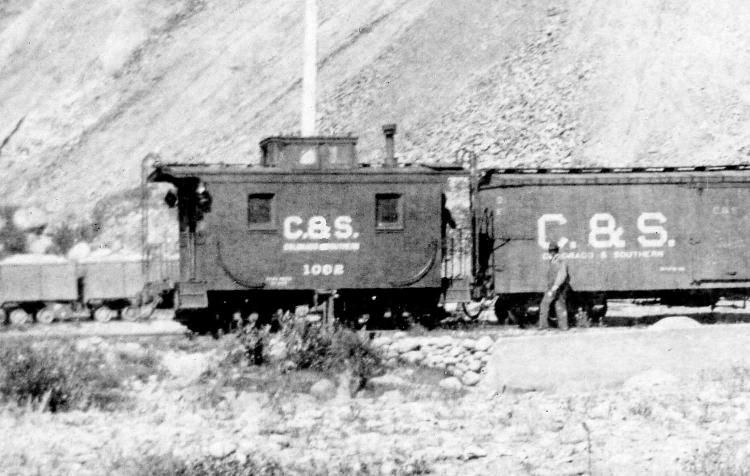 Jim, I don't have a solid conviction that the 12th car was 303. I've pointed out that the 1903 dimensions of 303 were the largest of the cars notated though we have to believe 302 would have been even bigger. For a car that could have been the very oldest of all the ng cabooses it seems pretty "heavy". But that is no argument. Nothing says the oldest cars had to be the smallest nor would it account for the car having been rebuilt prior to becoming C&S. So you can't follow my thoughts beyond that - nope! No gut feelings on that one. (Gut feelings on other points are based on vague information and some deductive reasoning but liberally doused with caution.) And I cannot answer the questions concerning similarity between 303, 306, and 310 for any given point other than to refer back to the 1903 roster where 303 was 14' 6" long inside, 306 was 12' 6" inside and 310 was 12' 4" inside. 303 was also 5 " wider than the other two. So they were not exactly alike. Furthermore if the 1903 dimensions are to be taken as accurate long bodied cars were more a result of the 1908 rebuild. For instance 300 and 301 were the shortest of all the dimensions noted (11'10.5" inside). 310 was actually 1 inch longer that 311. 304 was not noted so we don't know if 1003 was always long or not. But the overall jest is that they were all about 13' long door knob to door knob (except 303). Good luck with your caboose retro program. I'm working on 304 and 300 right now. Well... "right now" being more of a concept than a reality... Post photos as Derrell likes photos. |
Re: Eight wheel Caboose on C&Sng?
|
In reply to this post by Richard Farmer
Richard, the cars went to the WP&Y in 1943 probably via the Chicago Freight Car Company. The Chronicle in Vol. VIII is not entirely correct in this regard. C&S 1005 became WP&Y USA 90851 as caboose 90851. It was reno'd. in 1944 to 851 and scrapped 1945. C & S caboose 1003 became USA caboose 90852 and was wrecked 1943. It was set out as a car inspector shack thereafter and went up in smoke in 1958.
I can understand your confusion and I'm not here to dispute that 1008 could have come from off line. I don't see strong evidence that it did, round corners, placement of the cupola, etc. notwithstanding. Those are not strong indication to me that another RR built them - frankly the UP built most of the cars at Omaha anyway. But you have the car in hand and may sense things a little differently. The bigger issue concerns the Westinghouse brakes. The DL&G Annual Reports are not very specific. The cabooses as a class were listed with Whse Brakes but that doesn't distinguish whether all of the cars had auto brakes or just some of them. I don't see auto brakes on 306. I'm not sure how many times any of the cars were rebuilt. It would seem that in the early '90s there was a surplus of cabooses as they dropped 5 cars between 1889 and 1993. When the Tunnel was reopened and the Trumble Magic came into full force it appears they encountered a bit of a pinch. Well at least a little one as one more car seemed to be enough; but not really if the car had been on line all along. So if they needed to rebuild cabooses multiple times I'm confident they would have done it Would adding a cupola require a rebuild (I've never rebuilt a caboose - not a 12" to the foot one). The photo of 306 doesn't cause me to believe it was substantially different from a pre cupola car - but it is just a 2-D photo. And for brake cylinders? I don't know the details of the original DSP&P frames to be able to assess how heavy they actually were - obviously the suspension was inconvenient to our perception of a brake cylinder. Sadly neither one of us have the proof to say with certainty this is what happened or that was the case. I wish we had more but for the most part I've shared what I know - including documents and drawings. In 1933 the C&S took a huge pile of paper out into the yard and burned it... a lot of answers went up in smoke; I'm sure. Keep up the good work. |
Re: Eight wheel Caboose on C&Sng?
|
This post was updated on .
In reply to this post by Derrell Poole
A very helpful response, indeed, Derrell!
First, the photo--amazing!! I had intuited that the C&S would have applied the small block monogram centered between the windows of 303 / 1002, and planned to letter my c1909 car as such. Well, I will center the lettering on my car; doesn't look like the C&S car painters used a ruler when they lettered 1002 after renumbering!! Seems like a common thread with the application of the lettering: The long bodied rebuilds (1000, 1003, 1009) had the small block monogram and lettering centered (kinda) between the single side window and the far end of the car, the short bodied rebuilds like 1007 (and presumably 1005, 1006, and 1008) had the small block monogram spread out, with the small block "C" and the "S" symmetrically at the ends of the car sides, outside the single window and the "&" centered, with some un-rebuilt cars (ie the 313 in Blackhawk) having the large block C&S applied in a similar manner; finally the small block monogram on the 1002 was an attempt at centering that missed! The information that you also provided in the text sure helps: "other than to refer back to the 1903 roster where 303 was 14' 6" long inside, 306 was 12' 6" inside and 310 was 12' 4" inside". It means that the 303 was a long body car before the 1908 rebuilding program started. Could be, in 1908 or 1909, that the car body of 303 was deemed in good enough shape and already roomy enough that the Master Car Builder decided not to waste time and money relocating the cupola to the end and the only changes were to the underframe, with the application of new intermediate sills, new cast journal pedestals (with the little cast "C&S") and updated brake cylinder and rigging. I'm pretty much decided to re-detail the 303 body to similar to that of the 306 photo of 1901, that you posted on another thread: Early straight ladders, 4-board running boards with short end overhang, corner cupola diagonal braces over lateral roof walks that were next to the cupola. But I will use the upgraded (Overland) frame, assuming that the 303 was one of the first cars shopped in 1908-1909. That would mean that the later ladders with ring tops and relocated lateral roof walks to the ends would have been added to the car sometime later, say 1911-12, just before the repainting / lettering as in the photo above. Of course, the other possibility (that would rain on my planned parade), was that the 303 was one of the last cars reworked in the 1908 rebuilding program--Folio 27 shows 306 / 1005 and 310 / 1008 still had center cupolas as of 1911-1912 but already had the relocated and ring topped ladders, an impressive detail for a folio drawing. So, Chris, if you have that firmly dated June 1909 photo of caboose 303 with the not yet rebuilt underframe, please post it now, before I commit myself to brass and solder and paint and decals! Derrell, thanks again for all the great information!
Jim Courtney
Poulsbo, WA |
Re: Eight wheel Caboose on C&Sng?
|
This post was updated on .
In reply to this post by Derrell Poole
Derrell,
is there any more to this picture or is that it? Looks to me to be up at the Alma Lincoln or the Stanley Con but on the Mainline opposite the Stanley, possibly the original Crockett or the Salisbury properties. There is a Buda SwSt without a target directly below the number 1002 and the proximity of the high level wastedump in the background plus the loaded mine orecars directly behind at C&S tracklevel, these elements don't happen very often around I.S. The Stanley Con main orehouse that Harry Brunk modelled had a 18" or 24" gauge mine tram crossing the C&S spur but no large dump directly behind it. Great find, this has really got me intrigued some!
UpSideDownC
in New Zealand |
Re: Eight wheel Caboose on C&Sng?
|
What is the purpose of the extension to the air line that I have seen hooked to the hand rail on the rear platform in several of the caboose photos I have seen on this thread?
|
Re: Eight wheel Caboose on C&Sng?
|
Robert,
The hose that you mention is a back up hose, It is popularly called a Monkey Tail. These hoses usually have a high pitched air whistle and a dump valve. The main purpose for these hoses is so that a Brakeman or Conductor, while the train is backing up, can warn unwary pedestrians, drivers, animals, etc. that the train is close. The dump valve is used to dump the air in the air line and cause an emergency application of the train brakes should the occasion arise. Some old head Queens and Ground Pounders were so good with those dump valves that they could set up the air just like the Hogger would do it, except from the rear end of the train. Rick |
Re: Eight wheel Caboose on C&Sng?
|
This post was updated on .
Forty some odd years ago, I worked my way through college and medical school as a brakeman for the Rock Island, working off the summer extra board in North Terxas. The same type of "monkey tail" was still in use on the CRI&P's bay window and extended vision cabooses of the late 1960s-early 1970s. By that time it had evolved to a vertical pipe coming up from the caboose end beam, with whistle and emergency brake valve fitted to the end handrail, next to the brake wheel. The whistle was indeed a high pitched, shrill, "peanut" type.
Jim Courtney
Poulsbo, WA |
Re: Eight wheel Caboose on C&Sng?
|
In reply to this post by Rick Steele
Rick, interesting stuff.
When backing, do both the engineer and the guy on the rear platform whistle at crossings? Or, is the brake just tooting as an extra measure? I trust that there were sufficient back up moves that the monkey tail was common practice, yet only #70 received a back-up light.
Keith Hayes
Leadville in Sn3 |
Re: Eight wheel Caboose on C&Sng?
|
This post was updated on .
Consider the caboose whistle as a bell for the caboose. The few times I used it, the little whistle would be used intermittently, as Rick states, to warn pedestrians or vehicles that the train was backing toward them without a headlight. While backing through a grade crossing, the whistle would be used for the typical - - o -- sound. While NG trains were short, the times we backed up on the RI, caboose first, the engineer might be 15 to 80 cars back and couldn't see the crosssing, so the rear end crew was responsible.
I think we may have discovered a new feature for the "sound car" decoder, if it doesn't already have it!
Jim Courtney
Poulsbo, WA |
Re: Eight wheel Caboose on C&Sng?
|
Jim, that is where I was going. <warning, change of topic>
I just washed the unpainted model in preparation for an ultrasonic bath before priming. I downloaded the soundcar manual but have not programmed the decoder yet. There is a peanut whistle which may approximate the sound. If the caboose is consisted with the loco, and you are in reverse, I wonder if both the loco and caboose whistles sound? Brother d may be able to clarify. As you point out, the Hogger can be some ways away and not know exactly when the train is approaching or entering a crossing. Leadville has a LOT of crossings, and they are all about five carlengths apart. As I move to operating the layout, how we move through the town safely without spending too much time whistling and upsetting the residents is a question to be reckoned.
Keith Hayes
Leadville in Sn3 |
Re: Eight wheel Caboose on C&Sng?
|
In reply to this post by Chris Walker
That is the entire photo as I have it Chris. It was noted as 1911 but since the car was not reno'd. 'til 1912 that isn't possible. I think it is a bit later than 1912.
|
Re: Eight wheel Caboose on C&Sng?
|
In reply to this post by Jim Courtney
Which means I godda add these to my cabooses with Sound car sos I can make 'em whistle when backing up.
|
Re: Eight wheel Caboose on C&Sng?
|
In reply to this post by Derrell Poole
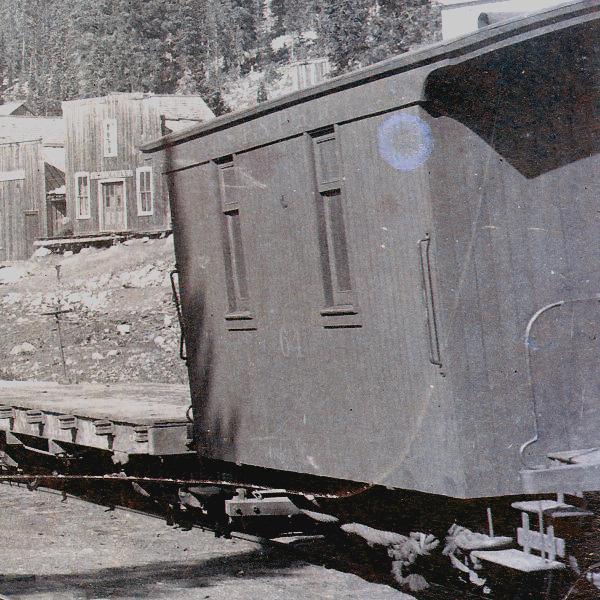 First things first; Derrell is in full blow geezerfication. Yep! I've been working on the process all of my life and it is finally catching up with me. Well, actually it has been in affect for some time but I swan to remember how long.... What were we talking about? Oh yeah. Previously I said - out of a pseudo moment of lucidity - that there were 4 cabooses with cupolas at Como in a late 1890s Scott photo. Magically - just to make a bonehead out of ol' Derrell - one of those cars has disappeared and now I can only count three! I posted this photo elsewhere and y'all trusted me because no one hunted it down and verified what I said. Bad on you...  I'm reposting the photo here because I want to make an observation; the arrows make it easier for you to find the 3 cars. There are 6 cars total that I see. That is at least half the fleet so in this view alone half the cars have cupolas. What I want to point out is this; every known photo of a pre 1890s waycar has two windows that top off at the fascia board. Even in the above photo all of the "waycars" (no lookout) have windows to the fascia. But the caboose (with lookout) to the far left has the little windows like those on 306 (and the photo of 1612). The car at the arrow in the middle also looks to have small windows. However the car on the right has windows to the fascia. 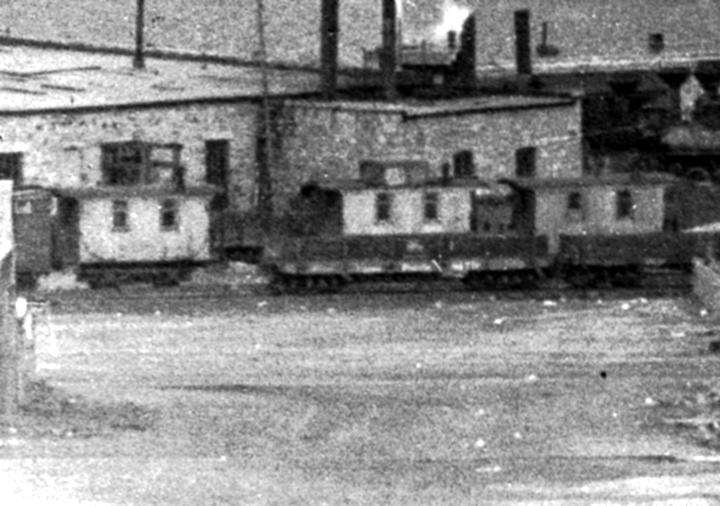 In this photo all three cars have windows to the fascia. 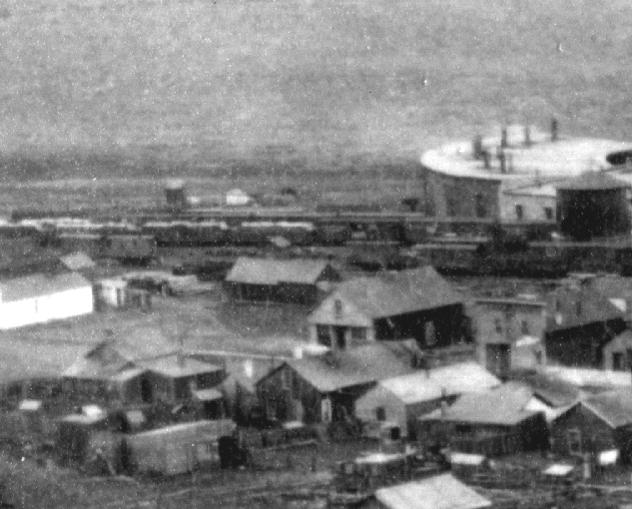 There are 4 waycars in this photo and they all strike me as having windows to the fascias. The car on the right appears bigger than the others and may have 3 windows. There is an accompanying photo that puts the total of 6 cars in the yard that day; 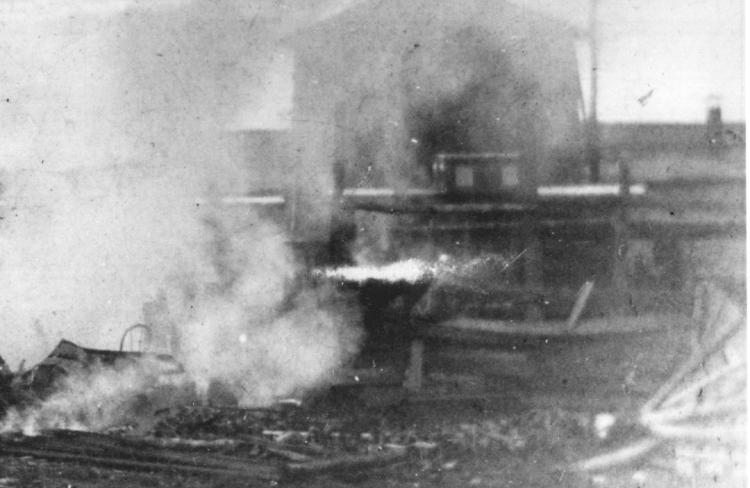 That would be this photo. Certainly the car on the right was a "caboose" while the car next to it is questionable. However there appears to be a break in the roof that suggests a lookout. Unfortunately we cannot see the windows. So what might all of this mean? Well, first I suggested there could have been cars originally built with cupolas - and there could have been. But it seems unlikely, or at least that such cars were sold or leased off line right away. More likely there were no such cars. But the windows in the '90s could suggest that some cars were rebuilt at different times from others and that tall windows suggest earlier occurrences while later rebuilds installed the small windows. OR. It could suggest that the cars with small windows did indeed come from a foreign road. Of course my primary question still stands - Where did they come from? The last Annual Report from the UP that listed the DL&G was 1893 with 11 cars. We assume this is correct and we tend to assume that this was the roster from that point to perhaps early 1898 (or whenever a 12th car would have been added). In support of Richard's argument about 1005 and 1008 coming from another road - and perhaps in support of Ron's suggestion 1601 returned to Utah - we cannot disprove that more cars were off roster after 1893 - even to the extent that 2 or even 3 were finally added (to make a total of 12). There are "logic" issues with this primus, specifically the inexplicable way the new cars were inserted into the vacancies of the roster. For instance, why would the new cars not be placed as consecutively as possible - that is why fill 1507 and then jump to 1514 when there were 1509, 1510, and 1512 vacant between 1005 and 1008? Why not 1501 and 1502 both of which were vacant? Furthermore, if the last listings of DL&G equipment in 1893 ORER included 1500 - and they do - and they listed the total at eleven, it makes no sense that they could have filled that number and gained a car (unless more than one car was added). The original 1500 would have had to vacate the spot in order for a new car to take its place. If 1500 was vacated and two cars were added why fill 1500 and then skip 1501 and 1502? Hmmmmmm? What if the UP AR was incorrect - remember how much trouble the DL&G Auditors were having concluding just how many cabooses they had? What if in reality there were still 12 cars physically on line in 1894 and that when the cars were relettered C&S there were NO new cars on line? 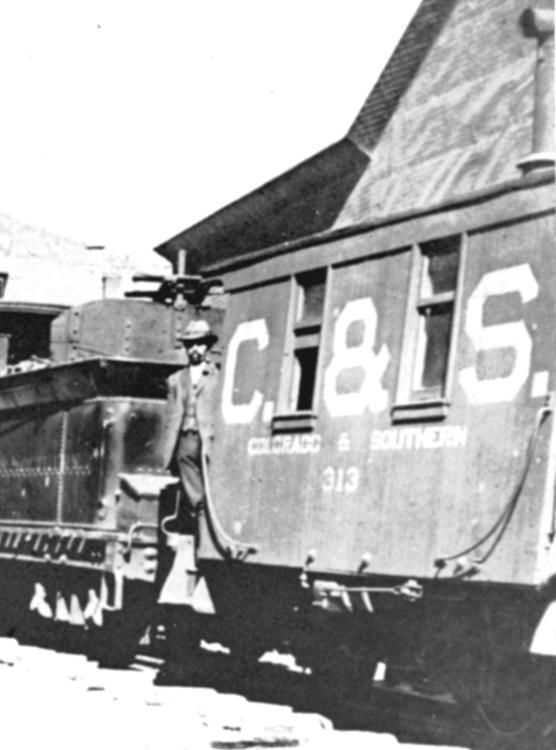 I also want to point out how the brake cylinder is mounted on this pre-rebuilt C&S "waycar". And that there are other unexplained bolts near the bottom edge of the body. We really don't know what the frame gear looks like do we? We assume it is much like the later cars and very different from what we see on 306, but is it? This is how a modernized car looked; 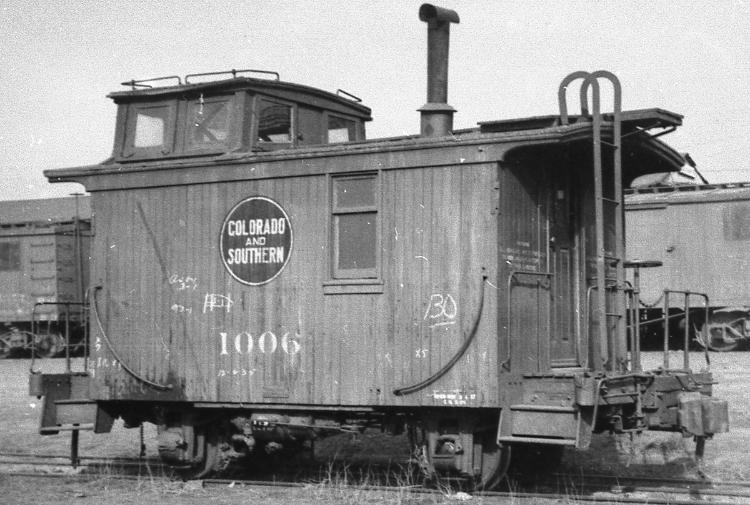 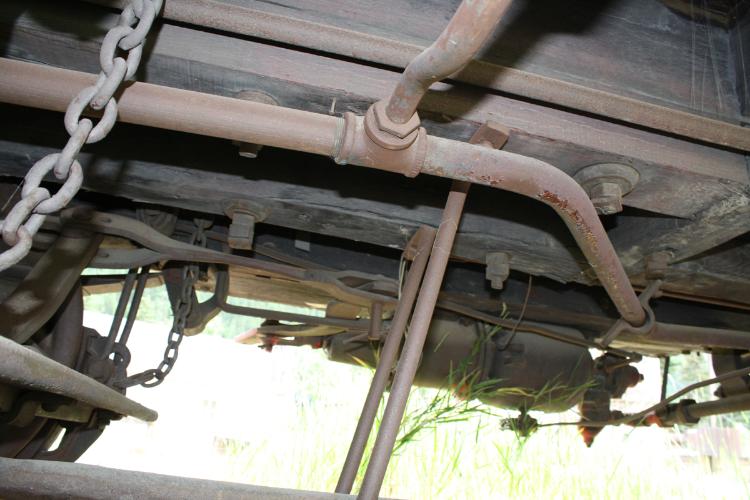 In fact, in both old and modernized cases the brake cylinder would have been well clear of the suspension gear. 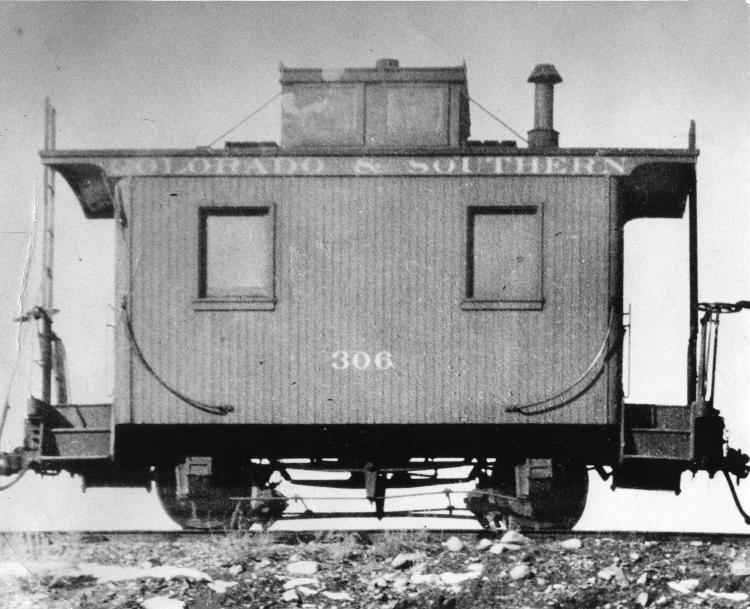 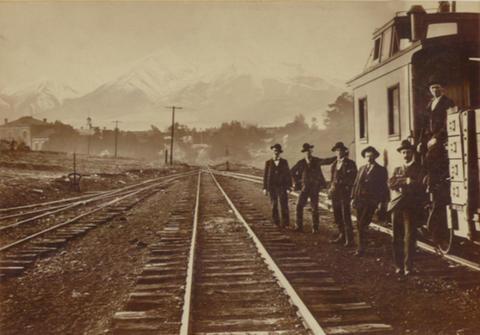 And btw I submit that what appears to be a wheel out of place is simply an air hose strategically drooping over the rail... Nor can we be certain this isn't 310. |
«
Return to C&Sng Discussion Forum
|
1 view|%1 views
| Free forum by Nabble | Edit this page |

